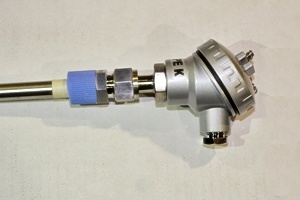MIMS Thermocouples – The Nicrobell® Approach
Introduction

Nicrobell® Pty Ltd, in conjunction with Incotherm Limited, have designed a thermocouple system, where both the sheath material and the element are mutually compatible. This has eliminated the problems with traditional MIMS thermocouple.
The Design Criteria
Traditional MIMS thermocouples were designed with the sheath and element treated as separate entities. These criteria firstly took into consideration temperature range, and then a sheath material was chosen to satisfy the process environment. This design had no consideration for the effects that the sheath has on the thermo-element and in the attempts to use MIMS thermocouples at temperatures above 1000°C (typically type K), evidence of thermal drift and premature element failure were prevalent. Research has shown that four factors are evident in realising the full potential of the MIMS design:
- The common sheath materials, Inconel® and AISI 310, will not withstand exposure in air or protective environments much above 1050°C. However, there is a need to be able to operate up to 1300°C.
- The type K thermo-element exhibits substantial thermoelectric instability on long-term exposure to temperatures above 1050°C.
- The thermo-element conductor wires can be contaminated by chemical elements, which thermally diffuse through the MgO, causing substantial drift in emf.
- By using dissimilar sheath materials with differential thermal coefficients of expansion as compared to the element wires, mechanical stresses imposed by thermal cycling can cause failure of the element (particularly the negative leg).
The integral designed thermocouple system

It must also take into consideration the problems evident in the conventional 300 series and Inconel 600 thermocouples (typically type K) presently being used.
If we look at thermoelectric stability, it has been shown that the type N bare wire thermocouple is substantially superior to that of E, J, K, and T up to about 1250°C. Therefore, the use of type N thermo-element wires in a MIMS format has the potential of providing a solution to the problems of stability, however any design must adopt a sheath alloy which is compatible with the type N wires.
Nicrosil was used in initial tests because of its superior oxidation resistance and being the same material as the positive leg of the thermocouple. This solved the problem of dissimilar metals and differential thermal co-efficients of the element wires and sheath. However, the thermo-chemical, aqueous corrosion resistance and carburisation resistance of Nicrosil are substantially inferior to conventional sheath materials.
Through a number of stages of development, the Nicrobell B sheath was developed. Nicrobell B is essentially Nicrosil, with a small percentage of Magnesium and Niobium added.
The addition of magnesium has the effect of increasing the oxidation resistance at elevated temperatures, by combining with the Silica contained in Nicrobell B to form a tenacious passive oxide layer of Magnesium oxy-silicate, which locks into the grain boundaries of the metal.
The addition of niobium has the effect of improving the thermo mechanical properties of Nicrobell B, and tests show that the ultimate tensile strength, rupture stress and ductility as a function of temperature to 1250°C are superior to Inconel and 310SS.
The fourth factor to be addressed is chemical contamination. Chemical contamination caused drift in the emf over time. Bentley and Morgan¹ attribute this to migration of aluminium and manganese by vapour diffusion through the magnesium oxide insulation. Nicrobell B has no aluminium or manganese, therefore elimination this contamination.
By using the type N thermo-elements, the short circuit migration of aluminium and manganese, typical of type K, is eliminated by virtue of the fact that these elements are not present in the type N conductors. Through the development of Nicrobell B sheathed type N MIMS thermocouples, industry now has a base metal thermocouple available with excellent oxidation resistance, high temperature strength, and high thermoelectric stability to temperatures in the range of 1250°C. Its performance compares favourably against that of the platinum-based thermocouples, without the inherent cost associated with rare metal thermocouples.
Nicrobell C – An addition to the nicrobell family
Although the Nicrobell B sheathed thermocouple exhibits many favourable attributes for high-temperature measurement in oxidising environments, it is not ideal in carburising, nitrating or sulphatising atmospheres present in processes using fossil fuels for their heat source.
The Nicrobell C sheathing alloy was developed by modifying the Nicrobell B sheath with the addition of chromium. Experience has shown that nickel chrome alloys with an excess of 20% chrome possess an enhanced resistance to chromium carbide formation.
Nicrobell C retains most of the advantages of the Nicrobell B alloy, apart from a slightly low high temperature strength. This has created a high-temperature sheath alloy which is resistant to carburising atmospheres, and also exhibits better resistance to sulphatising atmospheres.
Implications of using nicrobell sheaths with Type K Elements
All of the tests to date indicate that the N-clad-N approach provides the highest stability and performance for a MIMS thermocouple construction.
There are, however, many instances where it is not practical to change existing installations to type N thermocouples due to the cost of re-instrumenting or cabling the plant. In these cases, it is certainly worth considering the improvements available by changing to Nicrobell clad K thermocouples. Although not ideal, it supplies a partial solution to the problems associated with conventional sheathed type k thermocouples.
Analysing the factors represented in the design criteria:
- Use of the Nicrobell sheath provides extended high temperature resistance to oxidation.
- The Nicrobell sheaths do not possess aluminium or manganese, therefore eliminating the element contamination and effect on emf.
- The Nicrobell sheath has a thermal expansion co-efficient very close to that of the type K elements, therefore improving the thermocouple’s resistance to mechanical failure during thermal cycling.
- It should be noted that the type K thermo-elements still contain quantities of aluminium and manganese, which at high temperatures still have the effect of causing thermal emf instabilities.
Conclusions
A full range of Nicrobell alloy sheathed type N and K thermocouples have been introduced to the temperature measuring industry. They have been tried and tested in many environments where they have exhibited either far superior performance, stability or resistance to thermal emf drift than conventional sheathed thermocouples, or nearly equivalent performance to the rare metal thermocouples traditionally used for temperatures over 1000 to 1100°C.
In the case of platinum-based thermocouples systems, the cost savings available in using N-Clad-N up to 1250°C are substantial due to the high cost of platinum-based assemblies.
The economic advantages evident in the Nicrobell approach to MIMS thermocouples shows improved long-term stability and accuracy of plant life, and product quality.
Postscript
Since the writing of this article, the manufacturer of the Nicrobell products has sold the business to Tyco Thermal, and the name Nicrobell has subsequently disappeared from use. With more product development, a replacement material Pyrosil D has been produced to replace both Nicrobell B and C, showing properties more aligned to Nicrobell C than B, but with improved features allowing it to be welded more easily and drawn down without splitting.
The basic principles described in this paper apply to Pyrosil D.
Inconel™ is a tradename of the INCO group
Nicrobell® is a registered tradename of Nicrobell Pty Ltd Australia
References
- Bentley, R.E. and T.L. Morgan, 1986. Nickel-based Thermocouples in the Mineral-insulated Metal – Sheath Format: Thermoelectric Instabilities to 1100°C. Journal: Phys E19, 262-268.
- Burley, N. A. ,1992. N-Clad-N: A novel, integrally sheathed thermocouple – Optimum design rationale for ultra-high thermoelectric stability. American Institute of Physics, 579-584.
- Burley N. A. and J. Wroe. Advanced Integrally- sheathed type N thermocouples of ultra-high thermoelectric stability. International Seminar on Temperature Measurement and Calibration, 06.01-06.10.
- Furniss, C.P., 1993. Lower Operational costs in heat treatment and process engineering through improved temperature measurement.
- Furniss, C.P., 1992. Lower Operational Costs through improved temperature measurement in the Aluminium industry. Interkama 1992.


